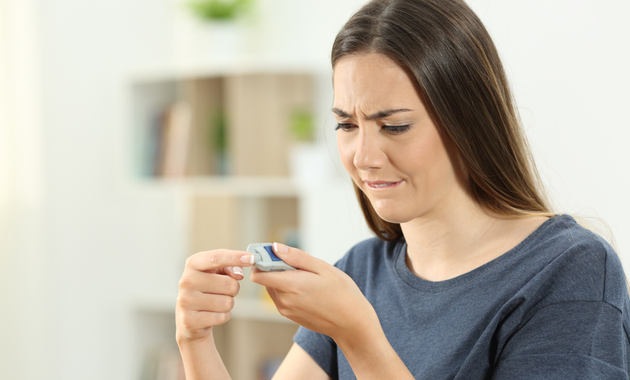
The importance of a regular blood glucose testing for diabetics cannot be emphasized enough. It helps to know how well your blood glucose level is faring with respect to your diet, exercise, and medications. And hence, investing in a glucometer to test blood glucose level at home is not a bad idea.
But there are times when you get abnormal results while using a glucometer. Most often than not, we tend to blame the glucometer. The fault might not always be that of a glucometer, especially if you have calibrated your blood glucose monitor and are following all the recommended guidelines. It could be due to some simple mistakes you make while checking your blood glucose levels and avoiding these mistakes can help you get better results.
Reduce your diabetes care expenses by up to 50%. Sign Up for 1mg Diabetes Care Plan.
Here are a few surprising reasons why your glucometer might be showing abnormal blood glucose readings.
#1. Not washing your hands before checking your blood glucose readings.
One of the most important tips to follow when testing your glucose levels with a glucometer is to wash your hands properly, even if your hands do not look dirty. This is because not washing your hands before testing can screw up the results. According to a 2011 study published in the journal Diabetes Care[1], there was a greater than 10 percent difference in the first drop and second drop of blood used to test blood glucose. Moreover, the error was more when the subjects touched a fruit just before getting checked.
It is advised to wash the hands with soap and water, dry them, and use the first drop of blood when using a glucometer to check blood glucose levels. If washing your hands is not possible and if they are not exposed to a sugar-containing product, it is acceptable to use the second drop of blood after wiping away the first drop to get the results.
#2. Testing too soon after eating.
Most people tend to test their blood glucose levels within 30 minutes or an hour after meals. However, testing too soon after your meals or snacks can give you results which are too high. According to experts, it is advised to wait for at least two hours after meals to test glucose levels to get the best reading. Also, checking prior to meals is a good idea.
#3. Misusing test strips and lancets.
To ensure that your readings are accurate and you experience less pain, it is important to use the right lancets and testing strips for your glucometer. Using expired or poorly stored test strips can result in inaccurate readings. Also, lancets can get dull and hurt if you reuse them.
For accurate results, use a fresh lancet every time you check your readings. Also, ensure the test strips are stored in a closed container away from direct heat and moisture. Do check the expiry date on the test strips before using as using expired test strips can cause abnormal readings.
Monitors, Lancets And Test Strips. One Stop Solution For Diabetic Patients…!!
#4. Squeezing your finger to get blood for testing.
In some cases, people who have cold hands or have poor circulation, squeeze their fingers to get enough blood for testing. However, this is not right as putting external pressure may lead to unreliable readings, revealed a 2011 study[1]. It is advised to gently warm the hands or rub your hands before testing so that you do not have to squeeze. Squeezing can cause interstitial fluid rather than blood to come out, which might lead to improper results.
Moreover, it does not matter which finger is used for glucose measurements but using the same finger all the time can lead to pain, discomfort and callus formation around the prick. Also, test on the edges of the fingertips and not on the fingertip where the nerves are located, which can lead to more pain.
#5. Not staying hydrated.
Simply put, dehydration can cause an increase in our blood glucose levels. When you fail to stay hydrated, it increases glucose levels in the blood. As a result, the concentration of the glucose in the blood circulation increases. This causes you to expel more urine, which in turn leads to dehydration. Hence, it is advised to drink fluids to avoid dehydration and changes in your blood glucose level.
**Consult India’s best doctors here**
In addition to this, selecting the right glucometer, setting up the right day, date and time, feeding the right code in the glucose monitor and checking the accuracy of your monitor periodically is a must to avoid abnormal readings. Remember that the best way to manage your diabetes is to test regularly, understand your results and track your readings to know if any changes are to be made to your diabetes management plan.
With inputs from Dr. Pradeep Gadge, Diabetologist, Mumbai.
(The article is reviewed by Dr. Lalit Kanodia, General Physician)
Recommended Reads:
Know Your Medicine: How To Use Insulin Injection For Diabetes
World Diabetes Day: Tips For Caregivers To Manage Diabetes
References:
1. Hortensius J, Slingerland RJ, Kleefstra N, et al. Self-monitoring of blood glucose: the use of the first or the second drop of blood. Diabetes Care. 2011 Mar;34(3):556-60.